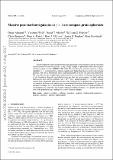Files in this item
Massive post-starburst galaxies at z > 1 are compact proto-spheroids
Item metadata
| dc.contributor.author | Almaini, Omar | |
| dc.contributor.author | Wild, Vivienne | |
| dc.contributor.author | Maltby, David T. | |
| dc.contributor.author | Hartley, William G. | |
| dc.contributor.author | Simpson, Chris | |
| dc.contributor.author | Hatch, Nina A. | |
| dc.contributor.author | McLure, Ross J. | |
| dc.contributor.author | Dunlop, James S. | |
| dc.contributor.author | Rowlands, Kate | |
| dc.date.accessioned | 2017-08-21T12:30:09Z | |
| dc.date.available | 2017-08-21T12:30:09Z | |
| dc.date.issued | 2017-12-01 | |
| dc.identifier | 250890714 | |
| dc.identifier | f49b04eb-11f2-4016-9297-c133165f5364 | |
| dc.identifier | 85044259258 | |
| dc.identifier | 000413082900012 | |
| dc.identifier.citation | Almaini , O , Wild , V , Maltby , D T , Hartley , W G , Simpson , C , Hatch , N A , McLure , R J , Dunlop , J S & Rowlands , K 2017 , ' Massive post-starburst galaxies at z > 1 are compact proto-spheroids ' , Monthly Notices of the Royal Astronomical Society , vol. 472 , no. 2 , pp. 1401-1412 . https://doi.org/10.1093/mnras/stx1957 | en |
| dc.identifier.issn | 0035-8711 | |
| dc.identifier.other | BibCode: 2017arXiv170800005A | |
| dc.identifier.uri | https://hdl.handle.net/10023/11520 | |
| dc.description.abstract | We investigate the relationship between the quenching of star formation and the structural transformation of massive galaxies, using a large sample of photometrically-selected post-starburst galaxies in the UKIDSS UDS field. We find that post-starburst galaxies at high-redshift (z > 1) show high Sérsic indices, significantly higher than those of active star-forming galaxies, but with a distribution that is indistinguishable from the old quiescent population. We conclude that the morphological transformation occurs before (or during) the quenching of star formation. Recently quenched galaxies are also the most compact; we find evidence that massive post-starburst galaxies (M★ > 1010.5~M⊙) at high redshift (z > 1) are on average smaller than comparable quiescent galaxies at the same epoch. Our findings are consistent with a scenario in which massive passive galaxies are formed from three distinct phases: (1) gas-rich dissipative collapse to very high densities, forming the proto-spheroid; (2) rapid quenching of star formation, to create the “red nugget” with post-starburst features; (3) a gradual growth in size as the population ages, perhaps as a result of minor mergers. | |
| dc.format.extent | 3482434 | |
| dc.language.iso | eng | |
| dc.relation.ispartof | Monthly Notices of the Royal Astronomical Society | en |
| dc.subject | Galaxies: evolution | en |
| dc.subject | Galaxies: formation | en |
| dc.subject | Galaxies: fundamental paramaters | en |
| dc.subject | Galaxies: structure | en |
| dc.subject | Galaxies: high-redshift | en |
| dc.subject | QB Astronomy | en |
| dc.subject | QC Physics | en |
| dc.subject | 3rd-DAS | en |
| dc.subject.lcc | QB | en |
| dc.subject.lcc | QC | en |
| dc.title | Massive post-starburst galaxies at z > 1 are compact proto-spheroids | en |
| dc.type | Journal article | en |
| dc.contributor.sponsor | European Research Council | en |
| dc.contributor.institution | University of St Andrews. School of Physics and Astronomy | en |
| dc.identifier.doi | 10.1093/mnras/stx1957 | |
| dc.description.status | Peer reviewed | en |
| dc.identifier.url | http://adsabs.harvard.edu/abs/2017arXiv170800005A | en |
| dc.identifier.grantnumber | ERC-2012-StG-20111012 | en |
This item appears in the following Collection(s)
Items in the St Andrews Research Repository are protected by copyright, with all rights reserved, unless otherwise indicated.

